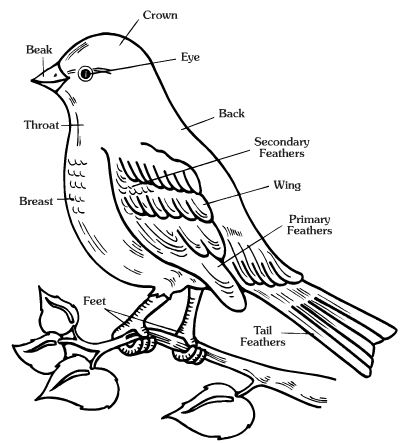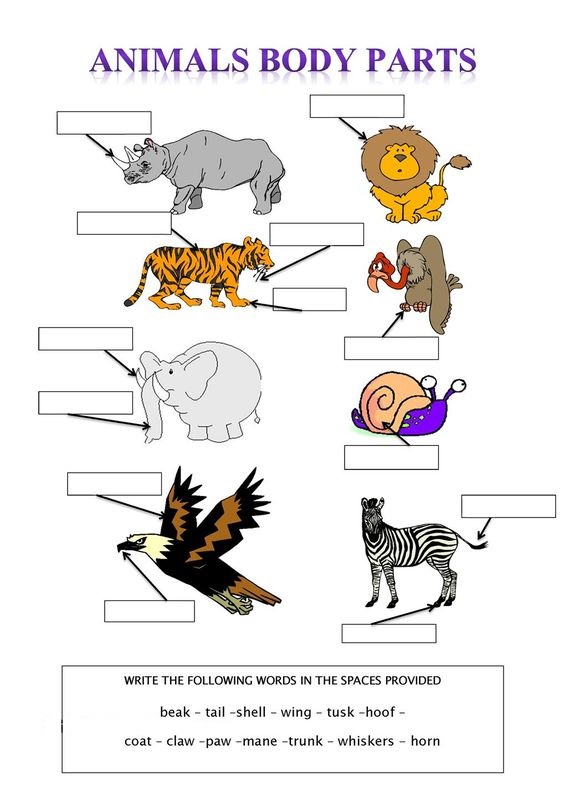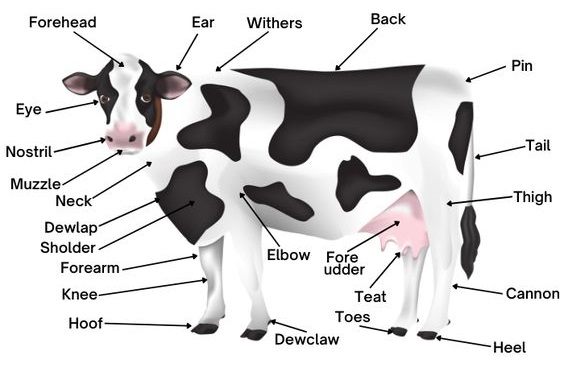Animals Body Parts: There are a large number of species found on our planet earth. These range from different Bird species to reptiles, mammals, insects and much more. To understand the operation of the animal kingdom, a crisp knowledge about animal body parts and functions these species requires to be attained by learners.
To make this job a little relaxed, this specific article has been penned down about animal body parts that help them to survive; and for the ease of learning about some of these animal species on earth solve body parts of animals worksheet, a list of animal body parts names are what the article contains to make learning more convenient.
Study the most important English Vocabulary Words identified by our experts and learn the right vocabulary to use in your day to day conversations
It also provides extra knowledge to those who wish to learn more about this topic.
List of Animal Body Parts
Name of Animal Body Parts
Description and Pictures on the List Animal Body Parts
Bee
Bees are unique insects closely associated with the wasp family. They are insects promoting pollination in plants and they are known to produce honey which possess commercial value in the market. They are of a variety of species and can be found in various habitats around the world.
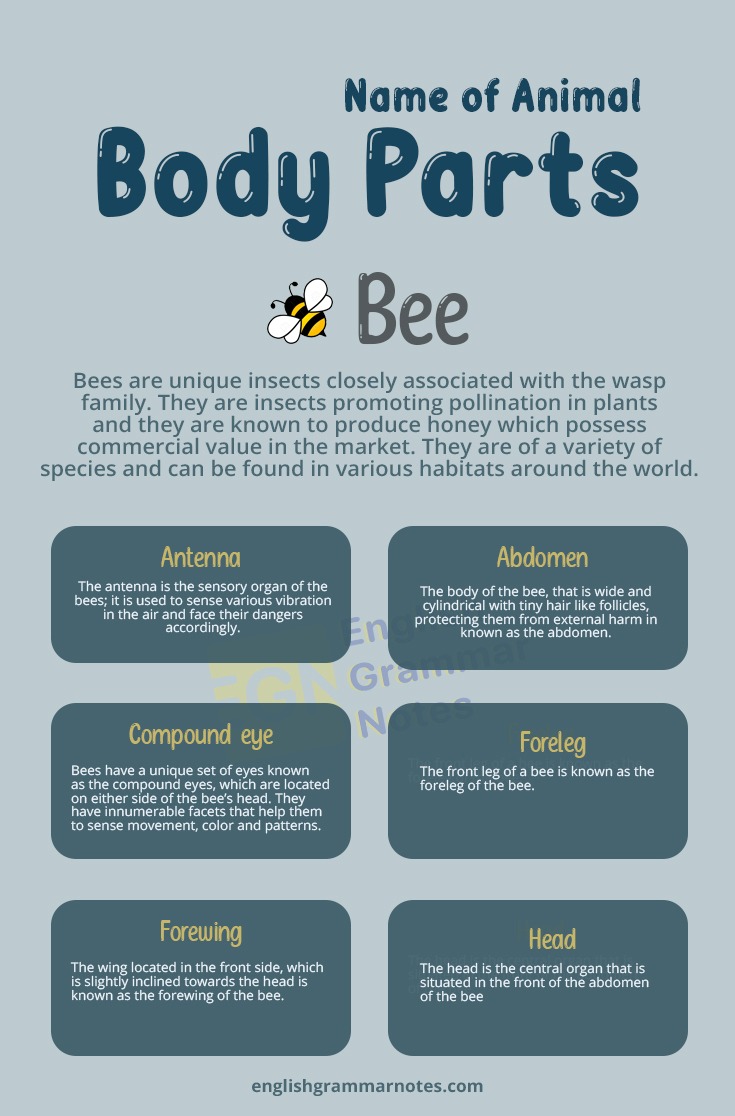
The parts of a Bee:
The body of the bee, that is wide and cylindrical with tiny hair like follicles, protecting them from external harm in known as the abdomen.
The antenna is the sensory organ of the bees; it is used to sense various vibration in the air and face their dangers accordingly.
Bees have a unique set of eyes known as the compound eyes, which are located on either side of the bee’s head. They have innumerable facets that help them to sense movement, color and patterns.
The front leg of a bee is known as the foreleg of the bee.
The wing located in the front side, which is slightly inclined towards the head is known as the forewing of the bee.
The head is the central organ that is situated in the front of the abdomen of the bee.
The hindleg is a set of legs located in the back side of the bee’s body.
The wing located in the back side, which is slightly inclined towards the tail end is known as the hindwing of the bee.
Mandibles are the part attached to the head at each ends of the labrum and they mostly act as the lower lip.
The middle legs are another pair of legs located in the middle portion of the abdomen area of a bee.
There are ten pairs of holes through which the bee respires, these are known as spiracles.
The tongue of the bee is known commonly as the glossa. It is either folded inside the mouth or pointed to draw signals through the air.
| Kingdom | Animalia |
| Phylum | Arthopoda |
| Class | Insecta |
| Order | Hymenoptera |
| Family | Apoidea |
| Genus | Apis |
| Scientific name | Apis mellifera |
Bird
Birds are a large conglomeration of an extensive group of feathered species, surviving in multiple habitats. They are flight-abled and lay eggs with hard calcareous shells and stiff beaks.
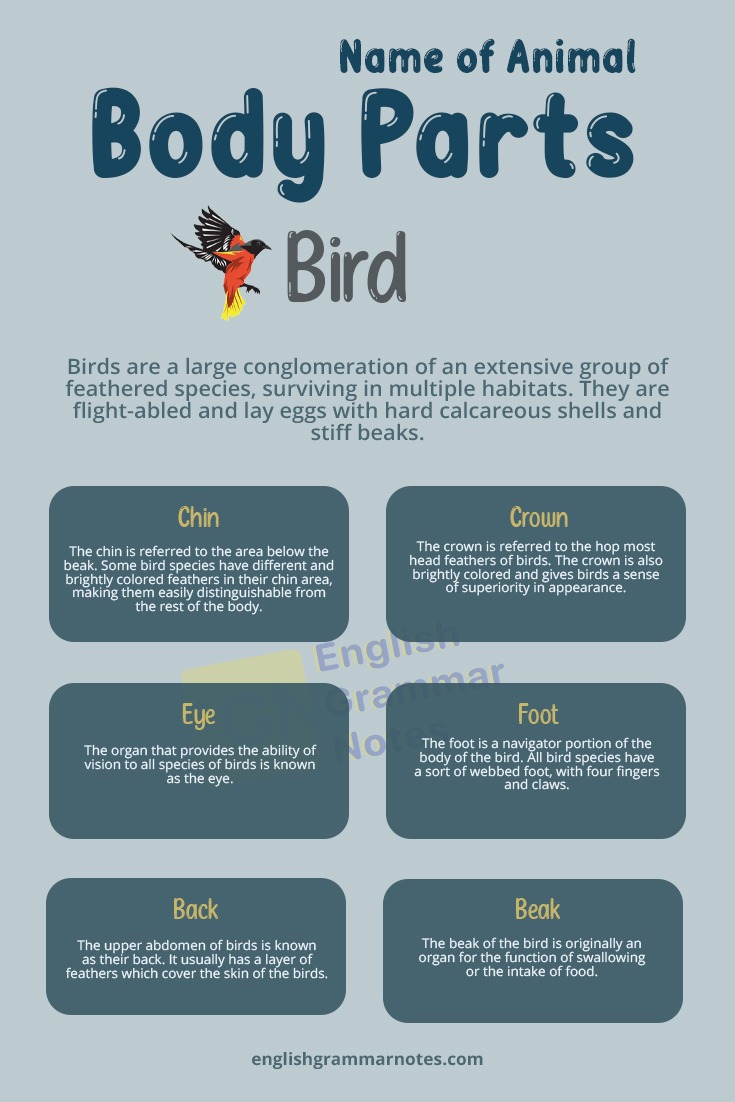
The parts of a Bird:
The upper abdomen of birds is known as their back. It usually has a layer of feathers which cover the skin of the birds.
The beak of the bird is originally an organ for the function of swallowing or the intake of food.
The chin is referred to the area below the beak. Some bird species have different and brightly colored feathers in their chin area, making them easily distinguishable from the rest of the body.
The crown is referred to the hop most head feathers of birds. The crown is also brightly colored and gives birds a sense of superiority in appearance.
The organ that provides the ability of vision to all species of birds is known as the eye.
The foot is a navigator portion of the body of the bird. All bird species have a sort of webbed foot, with four fingers and claws.
The forehead of birds referred to the area right above their eyes, this area is sensitive and often contains brightly coloured plumages.
The nape refers to the back of the bird’s head. It is soft and delicate and is covered by a layer of feathers.
The rump of the bird is the unique and distinct patch, that is located between the lower back and the tail.
The tail of the bird is the protruding back end of the abdomen. They mainly play the role of balancing the bird’s body and contains longer feathers compared to the rest of the body.
The thigh is hidden inside the belly of birds. They are covered by a thin and soft fur cover and usually are the upper portions of the legs.
The throat of the bird is the region starting beneath the beak to the middle of the belly of a bird. It is often distinguishable in many birds due to their color variations.
Undertail feathers are the types of feathers located on the underside of the tail of all bird species.
Undertail feathers are the types of feathers located on the upper side of the tail of all bird species.
The wings of a bird are the most vital and functional part. They help the bird in flight by providing a larger surface area for them to navigate through air like aeroplanes. Wings are also covered with various coloured feathers.
| Kingdom | Animalia |
| Phylum | Chordata |
| Class | Aves |
| Order | Passeriformes |
| Family | Passeridae |
| Genus | Passer |
| Scientific name | Passer domesticus |
Chicken
Chickens are under the aves phylum and have a stocky and rounded appearance. They are around less than 70 cm tall and weigh around 2.6 kg on an average.
Male chickens are called cocks or roosters, whereas; female chickens are termed hens. They are known for their fleshy combs, which are lobed wattles hanging below the bill.
Chickens have a high-arched tail that can extend more than 12 inches in length.
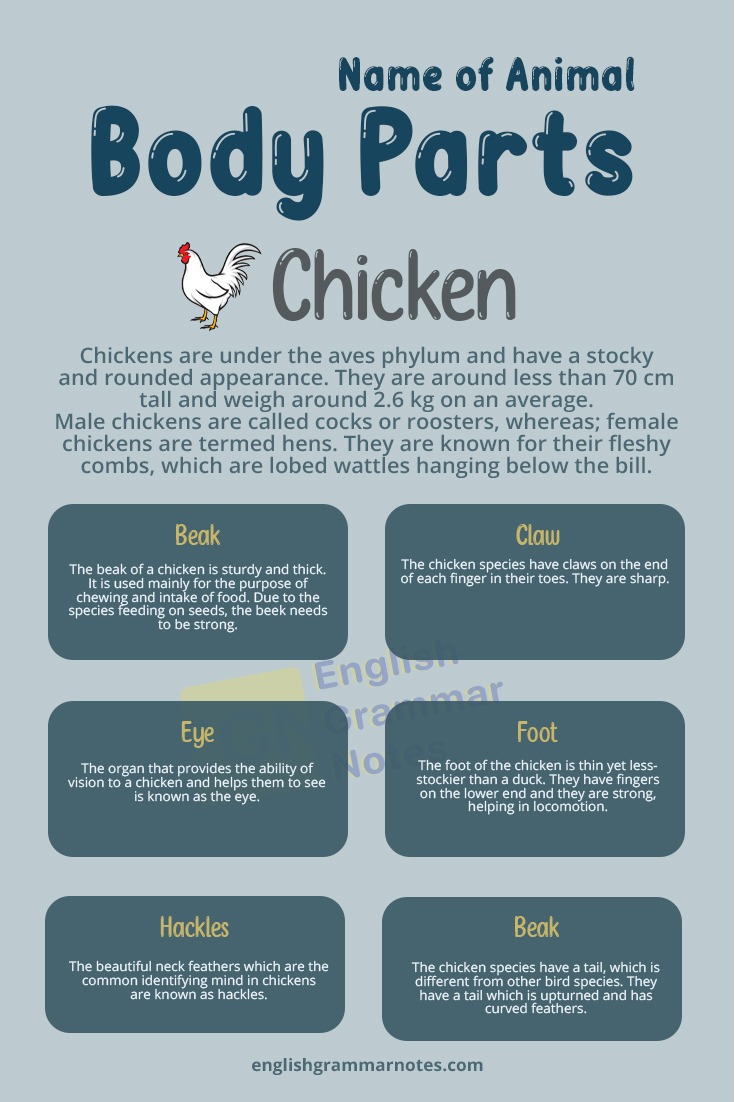
The parts of a Chicken:
The beak of a chicken is sturdy and thick. It is used mainly for the purpose of chewing and intake of food. Due to the species feeding on seeds, the beek needs to be strong.
The chicken species have claws on the end of each finger in their toes. They are sharp.
The organ that provides the ability of vision to a chicken and helps them to see is known as the eye.
The foot of the chicken is thin yet less-stockier than a duck. They have fingers on the lower end and they are strong, helping in locomotion.
The beautiful neck feathers which are the common identifying mind in chickens are known as hackles.
The chicken species have a tail, which is different from other bird species. They have a tail which is upturned and has curved feathers.
Chickens have tough thighs which are stocky and have feathers covering the skin.
The wattle is the reddish sack on top of a chicken’s head. It is a loose flap of skin which is also situated on the underside of the beak.
The wings of chickens help them to fly, but due to their bodies being robust and heavy, the cannot fly high into the atmosphere.
| Kingdom | Animalia |
| Phylum | Chordata |
| Class | Aves |
| Order | Galliformes |
| Family | Phasianisae |
| Genus | Gallus |
| Scientific name | Gallus gallus domesticus |
Cow
Cattle alternatively known as taurine cattle, or European cattle are a species of large domesticated herbivores. They are a unique and prominent member of the subfamily of Bovinae, which are the most widespread species of the genus of Bos. Depending on the sex of the species, they are referred to as cows or bulls.
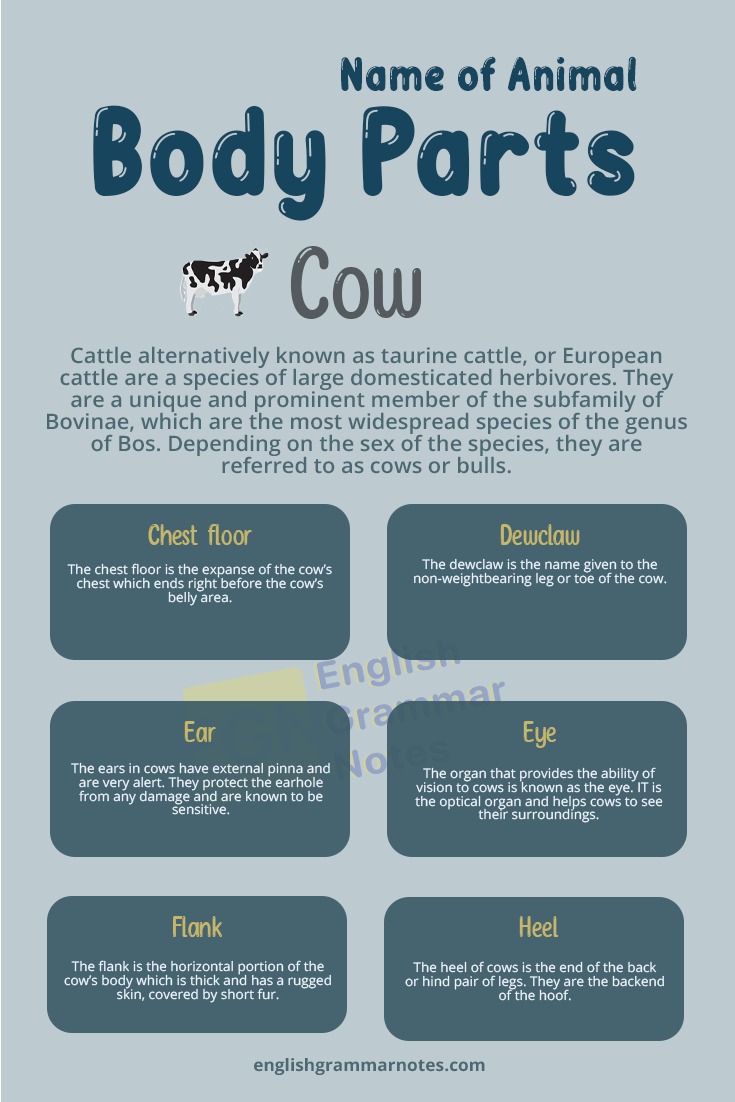
The parts of a Cow:
The chest floor is the expanse of the cow’s chest which ends right before the cow’s belly area.
The dewclaw is the name given to the non-weightbearing leg or toe of the cow.
The ears in cows have external pinna and are very alert. They protect the earhole from any damage and are known to be sensitive.
Elbow
The organ that provides the ability of vision to cows is known as the eye. IT is the optical organ and helps cows to see their surroundings.
The flank is the horizontal portion of the cow’s body which is thick and has a rugged skin, covered by short fur.
The heel of cows is the end of the back or hind pair of legs. They are the backend of the hoof.
The hoofs of a cow, are a rugged and stiff cover at the end of their legs due to them being animals used for domestication, grazing and ploughing fields.
Cows sometimes develop horns over time, and they are slightly curved upwards with a sturdy and tough structure.
The knee area of cows is the joint in their fore limbs. They have a pair of legs in the front of their abdomen, in which the mid-joint is known as they knee.
The breast of the cow or the front chest area is known as the tenderloin or loin in cows.
The portion that connects the cow’s head to the rest of the abdomen is called the neck. It is muscular and thick, with a soft fur coat.
The tail ear of all cow or bulls is the flexible and muscular structure with a tuft attached to the end of their tails to protect them from flies insect bites.
Cows also have muscular thighs that have more depth and volume in the upper portion as compared to the lower part, which ends into the hoof.
Withers are known as the ridge between the two shoulder blades of the cow’s abdomen, which is quadruped.
| Kingdom | Animalia |
| Phylum | Chordata |
| Class | Mammalia |
| Order | Artiodactyla |
| Family | Bovidae |
| Genus | Bos |
| Scientific name | Bos taurus |
Crab
Crabs are crustaceans of the infraorder of Brachyura, which specifically have very short projecting tails which are usually hidden entirely under their thorax. This species live in all the ocean, fresh water, and mostly sandy land. They are generally covered with a sturdy exoskeleton, and have a single pair of pincers.
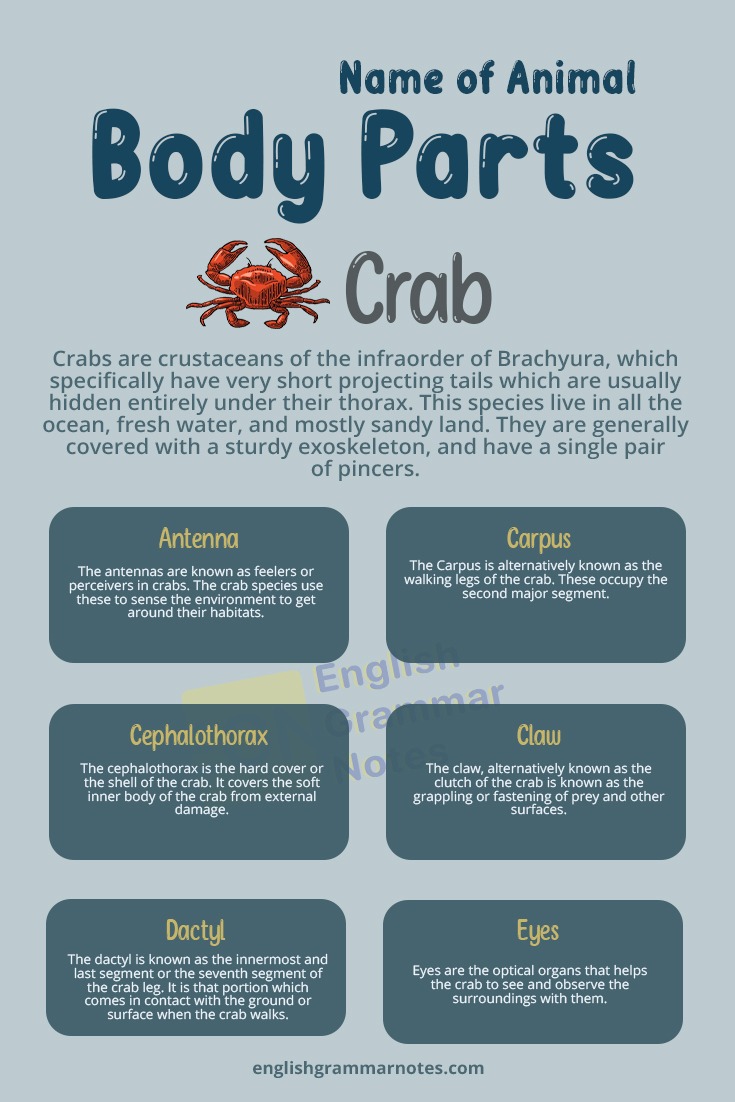
The parts of a Crab:
The antennas are known as feelers or perceivers in crabs. The crab species use these to sense the environment to get around their habitats.
The Carpus is alternatively known as the walking legs of the crab. These occupy the second major segment.
The cephalothorax is the hard cover or the shell of the crab. It covers the soft inner body of the crab from external damage.
The claw, alternatively known as the clutch of the crab is known as the grappling or fastening of prey and other surfaces.
The dactyl is known as the innermost and last segment or the seventh segment of the crab leg. It is that portion which comes in contact with the ground or surface when the crab walks.
Eyes are the optical organs that helps the crab to see and observe the surroundings with them.
The merus of the crab species is the fleshy upper portion of the crab leg, which is the portion between the shoulder and the knuckle.
The propodus is the major portion which makes up the claw or the clutch of a crab.
The swimming legs of a crab is the pair of fifth legs, that are attached to the abdomen of a crab’s body.
| Kingdom | Animalia |
| Phylum | Arthropoda |
| Class | Crustacea |
| Order | Malacostraca |
| Family | Decapoda |
| Genus | Dromiacea |
| Scientific name | Homoloidea |
Dog
The dog alternatively known as the domestic dog is a widespread, domesticated descendant of the popular grey wolf species. It has multiple notable characteristics, among which the most prominent of which is the upturning tail.
The dog is derived initially from an ancient, extinct wolf species. Currently, the modern grey wolf is the only known dog’s most proximate living relative.
The parts of a Dog:
Dog noses are generally cold and wet, and of course, they usually get stuck where they are not put to use.
comprised of the upper and lower jaws.
It is the portion of the head that is similar to the human forehead; it proceeds from the stop and the eyebrows to the back of the skull.
Different dogs have different types of ears such as Dropped, Pricked, Cropped and button.
Dogs have eyebrows that are most similar to humans.
The whiskers in dogs implement some sensory feeling.
Dogs have a nape which is the back of the neck. It is basically te portion where neck joins the base of the skull at the back of the dog’s head.
The neck runs from the head to the shoulders of the dog and is muscular and covered with fur.
It is the top section of the foreleg in the dog’s abdomen starting from the withers and going up to the elbow.
They are the top points of the shoulder blades, which makes them the highest point of the abdomen along the dog’s back.
The chest area in a dog is the entire rib cage segment in the underside of the dog.
The back of the dog runs from the mid of the shoulders to the estreme end of the rib cage.
Flank of the dog usually refers to the side portion of the dog which is between the end of the chest and the back leg.
It is the underside or the inner side of the dog which is the part from the end of the dog’s rib cage to its tail.
It is the back portion between the end part of the rib cage and the atarting of the pelvic or hip bone.
They are the vestiges of thumbs in dogs. Since dogs never used the opposable thumbs these dewclaws have turned into useless appendages.
They are claws inn the end of each toe of a dog that are actually included with the part of the last bone of the toes in dogs.
It is the part of the dog’s leg that is situated above the knee on the hind or the back leg.
It is the joint that is situated on the front of the back leg which is in line with the abdomen.
It is that part of the hind leg under the knee to the hock. In some dogs this portion has feathering along the back hocks.
It is the foreleg wich is right below the shoulder and it is comprised of the humerus bone, similar to the one found in the human own upper arm.
It is the first joint in the dog’s leg which is located just below the chest on the back side of the foreleg.
It is the lower joint which is situated below the elbow on the foreleg or front leg.
The foot at the end of each leg is called the paw, and sometimes called the forefoot or hind foot which depends on whether it’s front or back foot. The paw comes with nails and paw-pads.
The organ that provides the ability of vision to dogs and helps them to see their surroundings is known as the eye.
The tail of the dog is furry and thick with longer hair strands compared to the rest of it’s body.
The tongue of dogs are muscular and flexible with innumerable papillae.
| Kingdom | Animalia |
| Phylum | Chordata |
| Class | Mammalia |
| Order | Carnivora |
| Family | Canidae |
| Genus | Canis |
| Scientific name | Canis lupus |
Duck
The duck is the general name for numerous species of the waterfowl that falls under the family Anatidae. Ducks are commonly more petite and shorter-necked than swans and geese species, and are also members of the same family.
The parts of a Duck:
The foot is a navigator portion of the body of the duck. All duck species have a sort of webbed foot, with four fingers and claws enabling them to swim.
It is an organ of our body. It is utilized for the purpose of viewing objects, surrounds which are then transmitted to the brain of the duck.
The forearm of ducks is the set of arms located in front of the duck. They are stocky and strong.
Due to being a domesticated species and part of the aves class, ducks have a strong shoulder which is covered with feathers.
The tail of the duck is the protruding back end of the abdomen which is the extreme slender area. They mainly play the role of balancing the body of a duck and contains longer feathers.
Withers are known as the ridge between the two shoulder blades.
| Kingdom | Animalia |
| Phylum | Chordata |
| Class | Aves |
| Order | Anseriformes |
| Family | Anatidae |
| Genus | Anas |
| Scientific name | Anas platyrhynchos |
Elephant
The Elephant is a great and gigantic animal species which are believed to have morphologically developed from the pre-existing mammoths of the ancient age. They ate the biggest land animal species and the are herbivorous animals that have a great, sturdy body and thick skin.
The parts of an Elephant:
The elephant has small, jet-black eyes that help them in vision to view their surroundings.
Elephants have thick and muscular legs that are four in number and have rugged skin and hence are resistant to injury.
The tail ear of all elephant species is the tuft attached to the end of their tails to protect them from flies and other poisonous insect bites.
The toe of an elephant is cylindrical and thick, with a flat end on the underside. Elephants do not have claws like other animals.
The trunk of an elephant is a great and unique identifying feature. It is a long, muscular, cylindrical organ which is present in place of the nose and hence acts as the respiratory organs and has the ability of suction.
Tusks of elephants are a very important and exclusive characteristic feature. They are ivory white in color and also referred to as the ‘teeth’ of the elephant.
| Kingdom | Animalia |
| Phylum | Chordata |
| Class | Mammalia |
| Order | Proboscidea |
| Family | Elephantidae |
| Genus | Elephas |
| Scientific name | Elephas maximus |
Fish
Fishes are a unique type of aquatic animals who are devoid of limbs and are cold-blooded vertebrated living in all types of water bodies and possess commercial value in the world market,
The parts of a Fish:
The fin of a fish that is located near the excretory or sex-related organ in fishes is known as the anal fin.
The caudal fin is alternatively known as the tail fin and it is used for the purpose of propulsion.
The fin located on the dorsal side of a fish’s body is known as the dorsal fin.
The organ that provides the ability of vision to fishes is known as the eye. Fishes do not have eyelids.
The breathing organs that help fishes to absorb the oxygen mixed in water, and hand a filtering mechanism is called the gill of the fish.
The gills are covered by a hard calcium bone structure, to protect them from external harm, known as the gill cover.
The lateral line in fishes are placed laterally to indicate how the bone lies within their body.
The mouth of a fish is the oral organ that helps fishes to chew its prey for further digestion.
The nostril of fishes are respiratory organs, places on the tip oof their head, above the mouth.
Pectoral fins in fishes are fins that are present right after the end of the fish head and aids in locomotion.
Pelvic fins are a set of fins located on the pelvic side of the fish’s body.
Scales are a series of round, translucent and flexible cover that protects the inner body of the fish from external injury.
| Kingdom | Animalia |
| Phylum | Chordata |
| Class | Actinopterygii |
| Order | Cypriniformes |
| Family | Cyprinidae |
| Genus | Cyprinus |
| Scientific name | Cyprinus carpio |
Goat
The domestic goat, which is alternatively known as the goat, is a common domesticated species of a goat-antelope, which is typically kept as livestock.
This species was domesticated from the wild goat of the Southwestern regions of Asia and East Europe. The goat is a unique and herbivorous member of the animal family of Bovidae and the subfamily Caprinae; hence it is closely linked to the sheep and deer.
The parts of a Goat:
The brisket of a got is the rib region. It is situated in the underside or inside the chest cavity of the goat.
The dewclaw is the name given to the non-weightbearing leg or toe of the goat.
Goats have side-slanted eyes. Grazing animals are known to rotate their eyes when they bow their heads down for the purpose of grazing, efficiently keeping their eye slits approximately parallel to the terrain at all times.
Goats have slender but strong forelegs. They are the pair of legs present in the front portion of the abdomen of a goat.
The hoof of the goat species is a cloven hoof. It is split in between and has two segments on either side.
Some goats, especially males, develop horns over time, and they are slightly curved upwards with a sturdy and thick structure.
Goats are grazing animals and hence, their lower jaw ensures a lot of movement to help them chew the grass or plants for digestion.
The neck of the goat is not as long as a horse. It is relatively shorter and stocky, with a thick fur cover on them.
Goats have two nostril holes and they are set closely at the end of their muzzle. They usually breathe through their nostrils.
The goat rump is the detailed bone structure which joins the hip and pin bone joints.
Goats have a slim tail with a bunch of fur or hair attached to the end of it. They are quite flexible and primarily used for shooing away flies and insects.
Goats have muscular thighs that have more depth and volume in the upper portion as compared to the lower part, which ends into the hoof.
Withers are known as the ridge between the two shoulder blades of the goat, which is quadruped.
| Kingdom | Animalia |
| Phylum | Chordata |
| Class | Mammalia |
| Order | Artiodactyla |
| Family | Bovidae |
| Genus | Capra |
| Scientific name | Capra hircus |
Horse
The horse is a domesticated and hoofed mammal species, which belongs to the taxonomic family of Equidae and is regarded as one of two existing species in the subgenus of Equus.
Over the past forty five to fifty five million years, the horse has developed from a small multi-toed creature, known as Eohippus, into the large, single-toed being of today.
The parts of a Horse:
The belly of the horse is the underside of their abdomen. It is slightly lighter in color, compared to the other parts of the body and has a very thin layer of hair.
The breast area is the front end of the belly region. Female horses especially have apparent breasts to provide milk for their infants.
The cannon or cannon bone area is the chins of the horse. It is the area between the knee joint and the fetlock.
The croup helps the horse in the transfer of power and strength to the lower half of the body.
The ears in horses have external pinna to protect the earhole from any damage. They are sensitive.
The elbow area of horses is the joint in their fore limbs. They have a bone joint which is strong and flexible, letting the horse gallop.
The ergot is a less significant calloused underside of the hoof in horse species.
Horses possess a unique set of eyes that have equine vision. It has visual abilities which are directly associated with the behaviour of the horse.
The forearm of horses is the set of arms located in front of the horse.
Foreheads in horses is referred to the area between their eyes. It is sensitive and has shorter hairs.
Horses have hoofs, which are a rugged and stiff cover at the end of their legs due to them being animals used for battle. Their morphological development has developed stronger hoofs overtime.
The knee area of horses is the joint in their fore limbs. They have a strong bone joint.
They have grazing muzzles which prevent them from excess grass intake during grazing or eating grass.
The neck area is longer than other animals, it is muscular and it starts beneath the lower jaw or chin and ends before the chest area.
Horses have big nostrils that are utilized for respiration. These are set in front of their face.
The poll of the horse is the expanse of skin behind the horse’s ears.
Due to being a domesticated species, morphologically evolving from the Eohippus, the horses have a strong shoulder.
The stifle is that part of the horse where the hip-bone forming bone, meets the gaskin.
Horses have a tail which is thick and contains a collective bunch of longer hairs. It is also known s the dock, in all horse species.
The thighs of horses is very strong, especially due to them being carriers of load and people.
The withers are the area between the two shoulder blades of the horse’s back.
| Kingdom | Animalia |
| Phylum | Chordata |
| Class | Mammalia |
| Order | Perissodactyla |
| Family | Equidae |
| Genus | Equus |
| Scientific name | Equus caballus |
Turtle
A turtle is a common and popular reptile species found mainly in marshy or watery areas with a temperate climate. They have a calcareous shell that protects them from environmental harm and attacks against predators.
The parts of a Turtle:
The end portion of the limbs, which have sharp nails attached to them is called claw.
The calcareous shell made to protect the soft body of turtle, which is tough and thick, is called the coastal shell.
The optical organ that helps turtles to see is called an eye.
The fore limb or the leg in the front of the body of a turtle is known as front leg.
The major organ which contains the brain, which is responsible for the neuro-responses is called the brain.
The back limb or the leg in the back of the body of a turtle is known as hind leg.
The tortoise has tiny teeth for the purpose of chewing food. The lower jaw, consisting of many small teeth is known as the mandible.
There are a total of twelve pairs of marginal shield present in the turtle anatomy; which covers all the corners and edges of a turtle’s abdomen.
The organ of the turtle that helps them to intake food and chew, for the purpose of digestion is called mouth.
The portion that connects the turtles head to the rest of the abdomen is called the neck.
The sensory organ that is used to breathe and smell is known as the nose.
The nuchal shell is referred to as the front and the centre pieces of the slider turtle shell.
The pygal shield or shell is the portion of the turtle shell which is situated right abobe the tail of a turtle.
The organ at the extreme backside of the turtle, which is a small muscular and slim organ, used for the sense of balance is called the tail.
The shell attached to the vertebral column of a turtle is known as the vertebral shell.
| Kingdom | Animalia |
| Phylum | Chordata |
| Class | Reptilia |
| Order | Testudines |
| Family | Emydidae |
| Genus | Terrapene |
| Scientific name | Terrapene carolina |
